|
| |
Widescreen Weekend 2000 Review
Pictureville,
Bradford, England
|
This article first appeared in
..in 70mm
The 70mm Newsletter |
|
Written by: Widescreeners. Pictures by: Thomas Hauerslev |
Issue 61, June 2000 |
How
wonderful
|
|
|
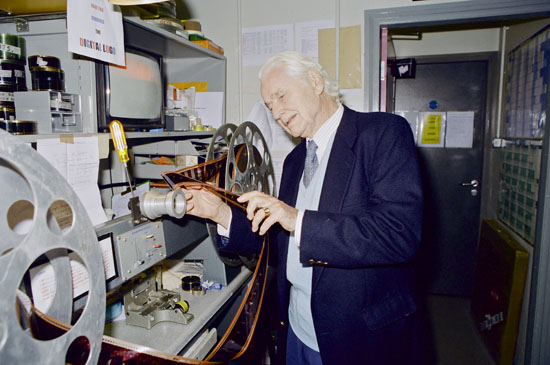 Guest
of honour, film director Ken Annakin inspects 70mm print of “Battle
of the Bulge”. Guest
of honour, film director Ken Annakin inspects 70mm print of “Battle
of the Bulge”.
I
thought the Bradford Wide Screen Weekend 2000 was terrific. How
wonderful to see the movies one made for the cinema instead of all the
little multiplex houses, video or cable. As I looked at many of the
scenes in “Battle of the
Bulge” the thought passed through my mind - how the hell did we
set up that scene with all its tanks and action?! And
I remember in the ”Magnificent Men” sequence of the day the planes were to take
off. I thought, “Those 50 or 60 veteran cars, we persuaded them to
drive around our airfield, on their way back from the Brighton Rally,
and we had a crowd of 2000 plus our 20 old planes...and on that Cinerama
screen we saw them all!!!!”
That
is what picture making should be all about, and it is no longer - or
very rarely.
Ken
Annakin
Beverly Hills, California, USA
|
Further in 70mm reading:
Widescreen Weekend 2000
•
Gallery:
2000
• WSW Home
• Through the Years
• The Best of WSW
•
Academy of the WSW
•
Creating the WSW
•
Planning the WSW
• Projecting
the WSW
•
Home of
CINERAMA
•
Projecting CINERAMA
Internet link:
|
More
70mm Festivals!
|
|
|
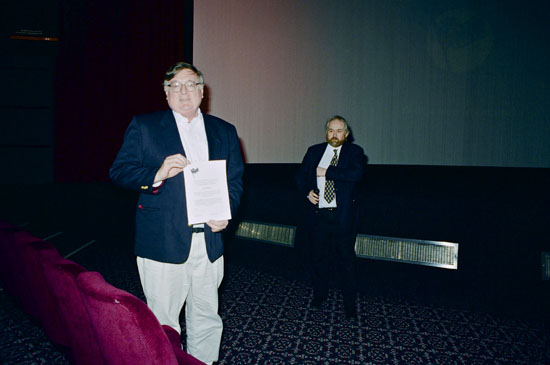 John
Belton, author of Widescreen Moview John
Belton, author of Widescreen Moview
This
was my first trip to Bradford and I don't think I had ever seen so many
large format films together at one time. The experience was so powerful
that I must admit that seeing a few short films in the program in 35mm
was a dramatic let-down.
Though
faded, "Windjammer"
was a reel treat--cramped quarters below deck were even more
claustrophobic than I remembered; on-deck scenes and port visits became
explosive bursts of open-ended space by comparison. The Technicolor
print of "How the West was Won" gave some idea of what the film
looked like back in the 1960s. It was interesting to see how the John
Ford segment used diagonal staging in depth for each of the side panels,
leading the eye into the background. You can actually feel the image
pulling the eye into depth in different directions.
Director
Ken Annakin was a real pleasure--there's an intelligence and generosity
to him that are also core elements of his films. "Those
Magnificent Men in Their Flying Machines" and "Battle of the Bulge" were both machine-spectacles
(airplanes and tanks). Annakin seems to have a fascination for these
products of the 20th Century. Though he spoke of the tanks as
"monsters," I suspect he is partially entranced with them.
Unfortunately, I had to leave before "The
Longest Day". All in all, it was a very good line-up of films.
I came away convinced, more than ever, that we need more 70mm festivals
like this so that the current generation of moviegoers (who have never
seen 70mm widescreen) can get a sense of the power of that format.
John
Belton, New York, USA
|
|
Pictureville
Was Great
|
|
|
I
only saw two films (“Windjammer”
and “HTWWW”) but didn't
attend any of the lectures or other screenings. I thought Pictureville
was great and I'm grateful for places like that, which give us the
opportunity to revisit the grandeur of widescreen films as they were
meant to be seen.
Gerardo
Paron, Los Angeles, USA
|
|
A
Wonderful Time
|
|
|
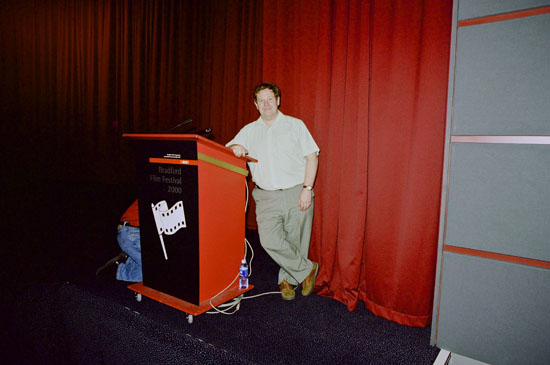 Dion
Hanson giving a talk Dion
Hanson giving a talk
Another
great weekend. "Those
Magnificent Men In Their Flying Machines" and "Chitty
Chitty Bang Bang" get my vote as the films of the festival,
although the fading on the latter was particularly sad given how
gloriously colourful this film should look.
"The
Longest Day" was a most enjoyable film, but it made a good
advert for using 65mm source elements given the size of the grain
apparent in the blow-up (particularly on process shots). Cineramacana
was a highlight of the weekend yet again. Having said that, I think I've
now seen sufficient footage of female Russian parachutists to last a
lifetime, thank you.
I
suspect, given the ribbing it got, that I was one of the few in the
audience who actually quite enjoyed "A
Good Ship Citizen". It was very much in the style of Vic
Reeves' other (rather silly) comedy output. He's a bit of an acquired
taste, though, so I can understand the audience being a little perplexed
by it all. Showing
the DTS trailers gave a chance for the audience to directly compare
digital sound against analogue. The digital sound is very clean, but the
treble notes are far too shrill and nowhere near as pleasing to the ear
as those produced from magnetic soundtracks. It was pretty clear which
format was superior. The
news about the virtual inevitability of digital cinema replacing
celluloid was particularly depressing. I suggest that we large format
fans get organised. How about forming the "70mm Commandos" ?
We could all dress up in army uniforms and black berets, and go around
the country smashing up digital projectors!
As
for next year's festival, I understand that "2001:
A Space Odyssey" is (predictably) being re-released in 2001.
Hopefully not only will it be released in time for the festival, but
also in a 70mm print. I'd also like to see the new 70mm print of "Tron" which Disney re-released recently. The glimpse of "Ice
Station Zebra" got me thinking that this wouldn't be a bad
choice either (okay, it's not a great film, but it's no worse than, say,
"Song of Norway",
which was screened last year).
I
had only one minor complaint on the whole weekend - the showing of
"Keepers of the Frame" from what looked like an NTSC VHS copy.
Showing a video copy would have been poor enough without the video
recorder deciding to make matter worse with a large line of snow half
way through the screening. It was an interesting documentary, but I
thought it was a bit cheeky to be charging full price admission given
the poor quality of the source.
All
in all, though, I had a wonderful time and am looking forward to next
year already.
Allan
Young, England
|
|
A
Great Accomplishment
|
|
|
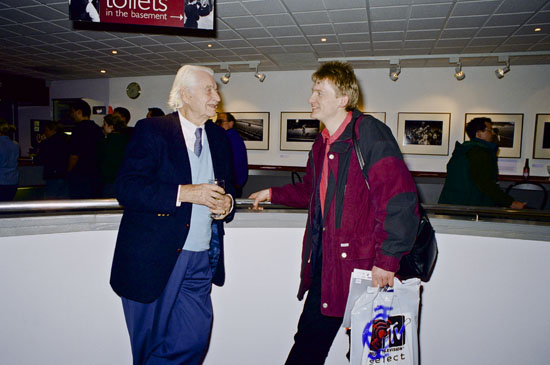 Ken
Annakin in conversation with Ingolf Vonau. Ken
Annakin in conversation with Ingolf Vonau.
Reading through a copy of the Yorkshire Post Supplement for The
Bradford Film Festival, confirms that this is an event of international
significance throughout the film world, and a great accomplishment for
all those involved in what must surely be an exercise of enormous
complexity. Securing sponsors of such integrity, and that are willing
and confident to support so worthwhile a project, surely, is initially a
challenge and ultimately a triumph.
It is obvious that everyone on the list of names at the bottom of
Page Two loves their job and is dedicated to the Museum and the success
of the Festival. But then, this Museum is unique.
Every visitor has his own favourites...and...yes... less than
favourite. Here are one or two of mine:
My
particular Widescreen Weekend began on a sad note. Aware throughout,
that this was to be the final screening of "How
The West Was Won". One cannot claim to have seen this truthful,
epic account of the exploration and expansion of The American West,
unless one has seen it in the originally-intended format, three-strip
Cinerama. The widescreen has never since been used nor exploited to such
dazzling effect. The great spectacular highlights: The River Raft, The
Indian Attack, The Buffalo Stampede, and The Train Robbery. This
treasure was rescued from a vault in Germany, where it had lain for many
years. Surely we must not allow this film to resume such a fate in
Pictureville's vault. Particularly since Pictureville is one of only two
cinemas in the world capable of screening it.
|
|
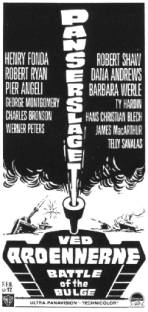 I
am no technician, so much of John Belton`s lecture went over my head.
However, it was reassuring to learn that the problem of security, and
interception piracy, makes global transmission of films a good many
years away. I
am no technician, so much of John Belton`s lecture went over my head.
However, it was reassuring to learn that the problem of security, and
interception piracy, makes global transmission of films a good many
years away.
"The Battle of the Bulge", and particularly the presence
of the man who directed it, Ken Annakin, made this a special occasion.
Among Mr. Annakin`s reminiscences, he recalled, "We were fortunate
in having six weeks of snow", an advantage that the most of us, and
apparently Charles Bronson too, would regard as a somewhat questionable
blessing. Despite Ken Annakin`s assertion that the only `plot` was the
relationship between Robert Shaw`s character, Colonel Hessler, and his
batman, this was gripping stuff. 70mm at its most effective. Those
damned tanks threatened to come right out of the curve of that screen
and flatten the first six rows.
This
was the third time I had seen Dion Hanson`s "Fantastic
Formats" presentation, and it is pure joy. (well almost). Who could
forget that immaculately-suited announcer in the Fox demonstration film,
produced to convince exhibitors that in order to screen authentic
CinemaScope, they had to invest in magnetic stereophonic sound? His
constant instructions to "Tom", an imaginary projectionist at
the back of the theatre, brought roars of laughter. This was just one of
so many instructive, enjoyable and nostalgic items, with which Dion
delighted us.
Initially,
the account of the continuing development of Dolby sound was intriguing
and interesting...until the demonstration. Mr. Hanson, it was TOO LOUD.
I instinctively checked the walls of the theatre for cracks. Afterward,
many of us crawled into the foyer, deafened, dazed, and searching our
pockets for Paracetamol. "Turn it down, Tom".
I
was not prepared for "Baraka".
Surely, film at its most sublime. Images that broke through the screen
and clawed at emotions. An audience stunned, overwhelmed, and sometimes
aghast at what it was watching. There were moments when I had to look
elsewhere. In an industry obsessed with box-office returns, how could
such a film come to be made? Who would finance a project that
acknowledges that the world`s cheapest commodity is human life?
|
|
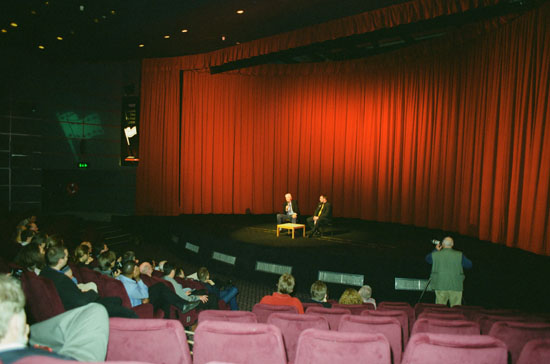 Ken
Annakin and Tony Earnshaw on stage in Bradford, March 2000. Image by Thomas Hauerslev Ken
Annakin and Tony Earnshaw on stage in Bradford, March 2000. Image by Thomas Hauerslev
Judiciously,
this masterpiece was saved for Sunday evening, the climax to days of
flawless projection and presentation.
However,
for those unable to stay until Monday morning, there was even more..."The Longest Day". Probably, the most authentic
re-creation of what happened on D-Day, and shown on that giant 70mm
screen. The cast had obviously been chosen with regard to their
nationality. The French actors spoke French; the German actors, German.
English translation sub-titles along the bottom of the screen.
Again,
at the conclusion of the film we were privileged to have an on-stage,
question-and-answer session with the film`s director, Ken Annakin, who
reminisced about Darryl F. Zanuck, Elmo Williams, and the making of the
film. Suddenly, a young fellow in the fourth row, (maybe the third)
jumped to his feet.
"Mr.
Annakin", he demanded, "I wonder whether a language-coach was
employed on this film to supervise the authenticity of the pronunciation
of the German language. It was rubbish", (I paraphrase). Then
followed The Longest Gasp. World War Three was about to break out.
Annakin waited until the uproar died down, and then, ever the English
gentleman, with directoral authority, serenely dismissed the youthful
upstart.
This
incident proved to be the dash of spice that flavoured the feast that
was Widescreen Weekend 2000.
Howard
Rust, England
|
|
|
|
|
Go: back
- top - back issues
Updated
22-01-25 |
|
|
 I
am no technician, so much of John Belton`s lecture went over my head.
However, it was reassuring to learn that the problem of security, and
interception piracy, makes global transmission of films a good many
years away.
I
am no technician, so much of John Belton`s lecture went over my head.
However, it was reassuring to learn that the problem of security, and
interception piracy, makes global transmission of films a good many
years away. Ken
Annakin and Tony Earnshaw on stage in Bradford, March 2000. Image by Thomas Hauerslev
Ken
Annakin and Tony Earnshaw on stage in Bradford, March 2000. Image by Thomas Hauerslev

 John
Belton, author of Widescreen Moview
John
Belton, author of Widescreen Moview Dion
Hanson giving a talk
Dion
Hanson giving a talk Ken
Annakin in conversation with Ingolf Vonau.
Ken
Annakin in conversation with Ingolf Vonau.